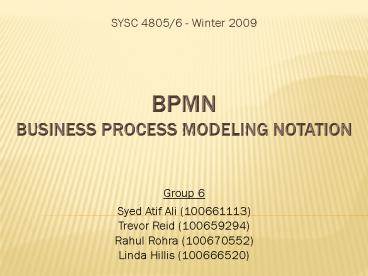BPMN Business Process Modeling Notation - PowerPoint PPT Presentation
1 / 28
Title:
BPMN Business Process Modeling Notation
Description:
Business Process Modeling Notation (BPMN) ... Two different types: Task: Sub-Process: Sub-Process can be included by other processes. ... – PowerPoint PPT presentation
Number of Views:1394
Avg rating:3.0/5.0
Title: BPMN Business Process Modeling Notation
1
BPMNBusiness Process Modeling Notation
- SYSC 4805/6 - Winter 2009
Group 6 Syed Atif Ali (100661113) Trevor Reid
(100659294) Rahul Rohra (100670552) Linda Hillis
(100666520)
2
Agenda
- Introduction to BPMN
- Graphical Elements
- Diagram views with BPMN
- Evaluation
- Conclusion
3
Business ProcessES
- A set of related tasks or activities which
produce a specific service or product for a
customer or group of customers - The field of Business Process Management (BPM)
attempts to optimize business processes
4
BPM Life-Cycle
5
Business Process Diagram (BPD)
Business Process Visual ARCHITECT 2.0 User's
Guide online Last Accessed March 20 2009,
Available at URL http//ds80-237-184-67.dedicated
.hosteurope.de/media/documents/bpva20ug/html/Ch06_
Business_Process_Diagram_Samples/Ch06_Business_Pro
cess_Diagram_Samples.html
6
BPMN
- Business Process Modeling Notation (BPMN)
- Defines a standard way of representing business
processes in Business Process Diagrams (BPD) - Goals
- Standard graphical notation
- Intuitive and understandable
- Bridge the gap between business analysts and
developers
7
GRAPHICAL eLEMENTS
- Purpose
- Symbolic
- Instant recognition
- Differentiate
- Four categories
- Flow Objects
- Connecting Objects
- Swimlanes
- Artifacts
8
Flow Objects
- These are the core elements of a BPD.
- Three types
- Event
- Activity
- Gateway
9
Flow ObjectsEvent
- What is an event?
- Represented by a circle.
- Three different types
- Start Event
- Intermediate Event
- End Event
- Can have a trigger or a result.
- Used to start, interrupt or end a flow.
10
Flow ObjectsACTIVITY
- What is an activity?
- Represented by a rounded edge rectangle.
- Two different types
- Task
- Sub-Process
- Sub-Process can be included by other processes.
11
Flow ObjectsGateway
- What is a gateway?
- Helps diverge or converge the sequence flow.
- Represented by a diamond.
- Branching.
- Forking.
- Merging.
- Joining of paths.
12
Connecting objects
- Helps connect the flow objects.
- Three types
- Sequence Flow
- Depicts the order of execution of the flow
objects. - Message Flow
- Depicts the flow of messages between two process
participants. - Associations
- Associates data, text and artifacts with flow
objects. - Used to show inputs and outputs of activities.
13
swimlanes
- Illustrates different functional capabilities or
responsibilities. - Two types
- Pool
- Depicts different business entities/participants.
- Sequence flow cannot cross the boundary of the
pool. - Message flow used for communication with another
pool.
- Lanes
- Depicts closely related but distinct
participants. - Sequence flow can cross over lane boundary.
- Message flow cannot be used between two lanes.
Name
Name
Name
Name
14
artifacts
- Help specify details.
- Do not alter sequence flow.
- Modelers can create their own to add more details
about how the process is performed. - Three pre-defined types are
- Data Objects
- Show how data is required or produced by
activities. - Group
- Grouping for better analysis/documention.
- Annotations
Annotation provides extra information. Analogous
to comments.
15
Internal markers
- Additional details can be added to core elements.
- Adds higher level of precision to the model.
- Example of internal markers to the events.
16
Views of BPMN
- Internal business processes
- Focus on the point of view of a single business
organization. - Defines activities that are not visible to the
public - Can be developed in parallel with other business
elements
17
Views of BPMN
- Collaborative B2B Processes
- Interaction between two or more business entities
only - Defines interactions that are public for each
participant - Shows less internal detail of the entities
18
Collaborative B2B Processes
19
SubProcess EXAmple
20
Mapping BPMN
- A bridge from the business process to a technical
executable - BPMN includes a partial mapping to Business
Process Execution Language (BPEL) - Changes in the BPMN model do not update in the
BPEL code
21
(No Transcript)
22
When to use bpmn
- UML Activity Diagrams similar to BPMN
- Different approaches
- UML system view, object-oriented approach
- BPMN customer view, process-oriented approach
- BPMN geared towards business analysts
- BPMN constructs are simplified
- UML notation too bloated
23
A good use of bpmn
24
A bad use of bpmn
25
But why is it a bad use?
- BPMN does not allow differentiation of multiple
elements - Many ASPs involved in the bidding
- But which ASPs placed bids and which did not?
- Cannot identify winning ASP, cannot assign task!
- BPMN lacks reference passing
- TaskPlanner cannot know which ASP completed a
task - It cannot even know if the task was completed
26
Other Disadvantages of bpmn
- No concept of process roles
- Cannot assign people responsibilities
- Difficult to define executions
- Think processor deployment functionality in
RoseRT - Semantic bloat
- Many variations of constructs defined,
specifically to map to executable models - Business analysts only use some constructs
27
Future directions of bpmn
- No standardized storage format
- Cannot exchange models between different vendor
tools - Format called XPDL working to solve this problem
- BPMN has not formalized execution semantics
- e.g., how is exception handling done?
- Many tools disagree with each other
- Work on BPMN meta-model aims to improve this
28
Conclusion
- Alternative development paradigm
- Allows process-modeling for business analysts
- User-centric approach rather than a
system-centric approach - Eases understanding and communication of business
processes within and across organisations - Cannot be applied in all scenarios































